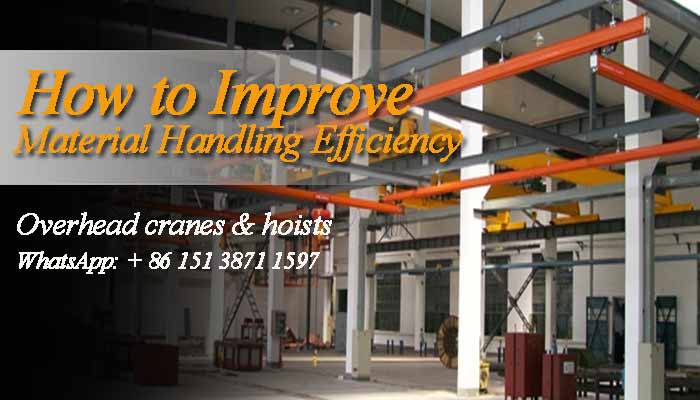
How to Improve Material Handling Efficiency in Your Assembly Line
Material handling principles,material handling equipment, i.e. material handling cranes and hoists, and 7 tips on improve your material handling efficiency in your assembly line production are presented for your renference.
Material handling can be defined as an integrated system for materials moving, handling, storing, and controlling by means of gravity, manual efforts or power activated machinery.Material handling is important for more than 80% of time materials or objects or loads spend on a shop floor is spent either in waiting or in transportation. With efficient material handling, time and space will be saved through handling, storage, and controlling of objects.
Material handling principles
According to the study by CIC-MHE and Material handling Institute, the following principles are compiled for material handling:
1. Planning principle:All material handling should be the result of a deliberate plan. The material handling plan should define the material (what), and the moves (when and where), and the handling method (how and who).
2. Standardization principle:Standardize the handling methods and equipment wherever possible.
3. Ergonomic principle:Human capabilities and limitations must be recognized and respected in the design of material handling tasks and equipment to ensure safe and effective operations.
4. Work principle:Material handling work should be minimized or simplified without sacrificing the productivity or the level of service require of the operation.
5. Unit load principle:Unit loads shall be appropriately sized and configured in a way that achieves the material flow and inventory objectives at each stage in the supply chain.
6. Space utilization principle.Effective and efficient use must be made of all available space.
7. System principle:All material handling activities should be integrated to form a coordinated, operational system.
8. Automation principle.Material handling operations should be mechanized and automated whenever is possible to improve efficiency, reducing cost and improving safety, etc.
9. Environmental principle.Application environment and conditions should be taken into consideration when designing or selecting the material handling equipment.
10. Life cycle cost principle.The economic analysis should be conduction on the entire life cycle of all material handling equipment.
Material handling methods
Generally speaking, material handling methods can be grouped into manual material handling, mechanical material handling, and automated material handling.
For different material handling environments and conditions, different material handling methods are adopted. Generally speaking, manual material handling has high flexibility but lower productivity while the automated material handling has high capacity but with lower flexibility, and the mechanized and soft automated material handling comes in between. The relation between flexibility and capacity of different material handling methods are shown in the picture for your reference.
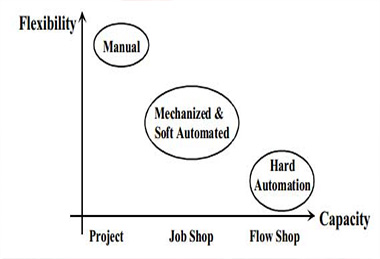
Types of material handling in your assembly line
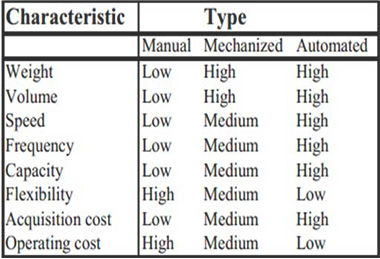
Charscteristics of different types of material handling methods
Material handling equipment & Material handling tools
Generally speaking, the following types of material handling equipment are involved in material handling.
- Transporting equipment, for material moving, such as, conveyors, cranes and hoists, and industrial trucks.
- Positioning equipment, to handle material at a single location, such as, lift table, dock lever, hoist, and industrial robot, etc.
- Unit load formation equipment, to handle and maintain material integrity during transporting and storing, such as, pallets, skids, bags, crates, etc.
- Storage equipment, to holding or buffer materials over a period of time, such as, drive-in rack, sliding rack, etc.
- Identification and control equipment, to collect and communicate the information that is used to coordinate the flow of materials within a facility and between a facility and its suppliers and customers.
Transport equipment
- Conveyors :1. Chute conveyor, 2.Wheel conveyor, 3. Roller conveyor, 4. Chain conveyor, 5. Slat conveyor, 6. Flat belt conveyor, 7.Magnetic belt conveyor, 8.Troughed belt conveyor, 9.Bucket conveyor, 10. Vibrating conveyor, 11. Screw conveyor, 12. Pneumatic conveyor, 13.Vertical conveyor, 14. Cart-on-track conveyor, 15.Tow conveyor16.Trolley conveyor, 17.Power-and-free conveyor, 18. Monorail, 19, Sortation conveyor
- Material handling cranes:Jib crane 2. Bridge crane 3.Gantry crane 4. Stacker crane
- Industrial trucks :1. Hand truck, 2. Pallet jack, 3.Walkie stacker, 4. Pallet truck, 5. Platform truck, 6. Counterbalanced lift truck, 7.Narrow-aisle straddle truck, 8. Narrow-aisle reach truck, 9.Turret truck, 10. Order picker 11. Sideloader12.Tractor-trailer, 13.Personnel and burden carrier 14.Automatic guided vehicle
- No equipment: Manual
Positioning equipment
- Positioning Equipment:1.Manual, (no equipment), 2.Lift/tilt/turn table, 3.Dock leveler, 4.Ball transfer table, 5.Rotary index table, 6.Parts feeder, 7. Air film device, 8.Hoist, 9.Balancer, 10. Manipulator /Industrial robot
- Unit Load Formation Equipment:1. Self-restraining(no equipment), 2.Pallets, 3.Skids4. Slipsheets, 5.Tote pans, 6.Pallet/skid boxes, 7.Bins/baskets/racks, 8. Cartons, 9.Bags, 10. Bulk load containers, 11. Crates, 12.Inter-modal containers, 13.Strapping/tape/glue, 14.Shrink-wrap/stretch-wrap, 15.Palletizers.
Storage Equipment
- Storage Equipment:l.Block stacking(no equipment), 2.selecak, 3. Drive-in rack, 4.Drive-through rack, 5.Push-back rack, 6. Flow-through rack, 7. Sliding rack, 8. Cantilever rack, 9.Stacking frame, 10. Bin shelving1, 1l. Storage drawers, 12.Storage carousel, 13. Vertical lift module, 14.A-frame, l5.Automatic storage / retrieval system
Identification and Control Equipment:
- Identification and Control Equipment:1. Manual(no equipment), 2.Bar codes, 3. Radio frequency, identification tags, 4.Voice recognition, 5. Magnetic stripes, 6.Machine vision, 7. Portable data terminals.
Material handling cranes and hoists
Material handling is typically done with cranes and hoists. Crane-handled loads are typically more varied in terms of shape and weight than conveyor-handled loads. Hoists are typically used in conjunction with cranes to lift, lower, and move goods or cargo.
General characteristic of cranes and hoists:
- Material handling is a term used to describe the process of moving materials from one place to another Cranes and hoists are used to transport goods horizontally and vertically inside the material handling equipment's covering area.
- Material handling cranes and hoists allow for more movement freedom than conveyors.
- Material handling cranes and hoists can carry items of varied forms and weights that would be too heavy for a conveyor to handle.
- Crane and hoist operation methods include suspension panel, driver's cabin, remote control, or a combination of the aforementioned.
- Floor space costs: Varied types of cranes and hoists require different amounts of floor space.
- Lifting height: high; can be modified to meet specific needs.
- Load capacity: Can be changed based on load requirements.
General application: Intermittently moving varied loads within the cranes and hoists' rated capacity to any location within the cranes and hoists' covering area.
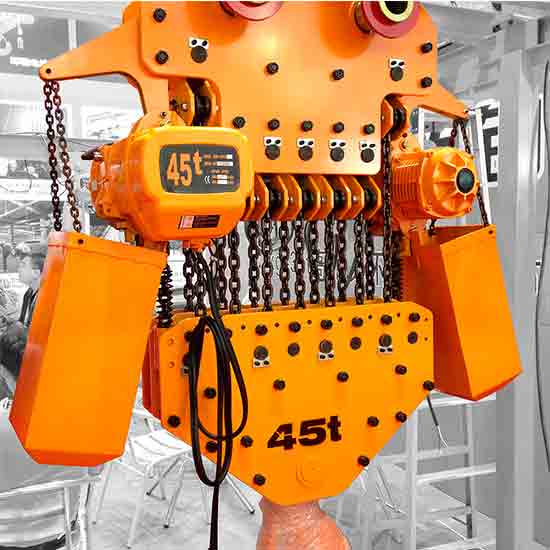
Electric chain hoists mounted on hook, lug, manual or electric hoist trolley for types of electric chain hoist cranes with capacity of 500kg, 5 ton, 10 ton, 32 ton.
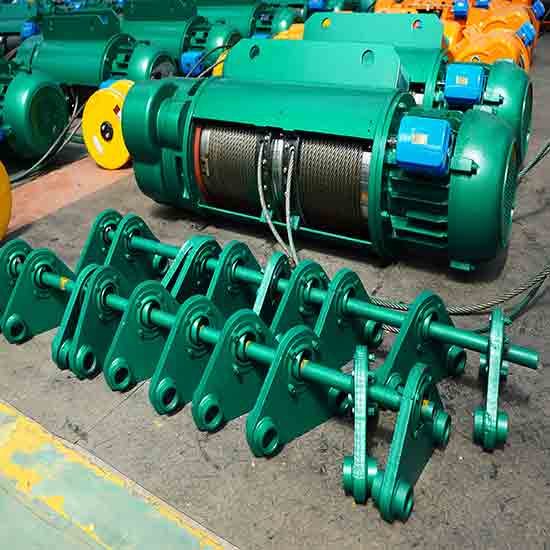
Types of wire rope hoists designs for overhead hoist cranes- explosion-proof cable hoist, low profile wire hoist & single & double girder hoists for your hoist cranes.
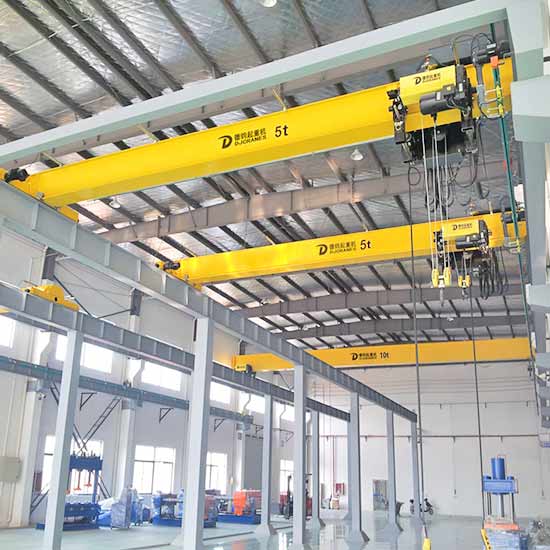
European standard overhead hoist crane, Small overhead crane:European single girder overhead cranes, compact FEM hoist crane design, small & light overhead hoist crane.
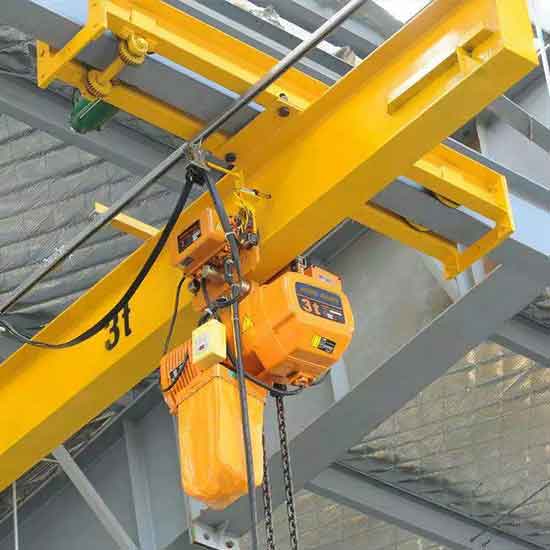
1 ton -10 ton underhung bridge crane, light single girder overhead crane design, suspended on overhead roof, free floor space, economical underhung crane.
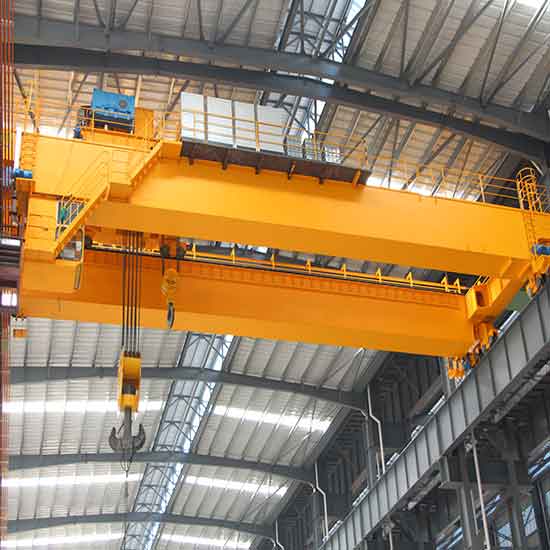
FEM/ DIN open winch bridge crane-European standard double girder overhead crane with open winch trolley, your heavy duty winch crane up to 320 ton.
Importance of efficient material handling in manufacturing workflow
It makes no difference what you make or how much demand you have for your goods. Your firm will not survive if you are unable to create your product efficiently (at a cost below its market value).You've probably already dealt with the issue of producing your goods with a reasonable profit margin in mind. However, you are now confronted with a new issue.Just because your product is profitable doesn't imply your competitors aren't making a similar thing for less money.
If this is the case, your competitors will either 1.) make more money than you, which is not a good thing. Or 2.) they'll be able to offer their product for less money than you do, which isn't a good thing.
Only by spending less money on your goods than your competitors can you prevent either of these consequences.
Tips on improve your material handling and manufacturing factory efficiency
Your factory's efficiency will have a significant impact on your manufacturing expenses.Some production cost factors are beyond your control. For example, the cost of materials or the cost of transporting them to your factory.Because there are so many variables outside our control, it's preferable to concentrate on the ones we can influence. The most important of these criteria is factory efficiency.The ten items listed below will assist you in increasing the efficiency of your factory and gaining a competitive advantage over your competitors.
1.Have the right tools
You'll need the appropriate equipment.If you don't provide your employees with the appropriate tools, they will make do with what they have.This can be extremely dangerous, and it will almost always make the job take much longer.Consider the difference between changing a tire with a standard lug wrench and using an impact wrench.It may take a few minutes with the lug wrench to remove all of your tire's bolts. It can take a few seconds for the impact wrench to remove those bolts.
In comparison to the lug wrench, the impact wrench will save you a lot of money in man hours if you change a lot of tires in your business.Not only will having the right tools help your employees to increase productivity, but it will also make them happier because they won't be compelled to waste time.
2.Organize your tools
It makes no difference if you have the best tools in the world if no one can find them.A hammer that is missing is the same as having no hammer at all.
I can't tell you how many hours I've spent looking for tools that were missing at some of my previous employment. It doesn't matter how many hours it is; it's much too many!I didn't enjoy it when I couldn't find tools, especially when I was being paid to do so!
Imagine paying someone to search for your tools for hours. You'd probably despise it even more than the employee on the lookout for them.Ascertain that your personnel are aware of where the tools are stored and that they return them there when not in use.
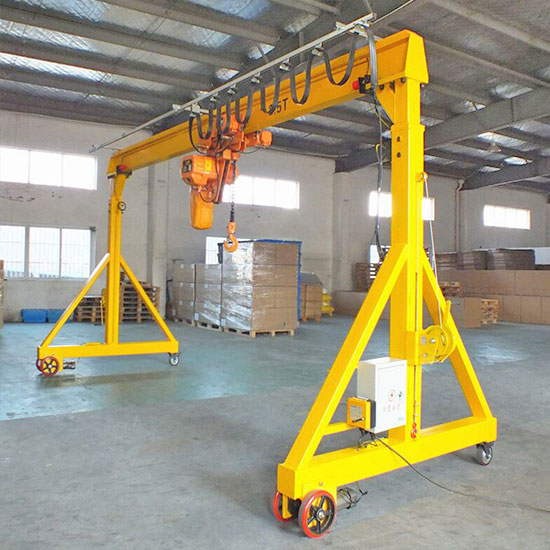
Portable gantry crane & Economical mobile gantry-250 kg - 10 ton portable gantry cranes & mobile gantry cranes with adjustable / fixed gantry for small & light material handling.
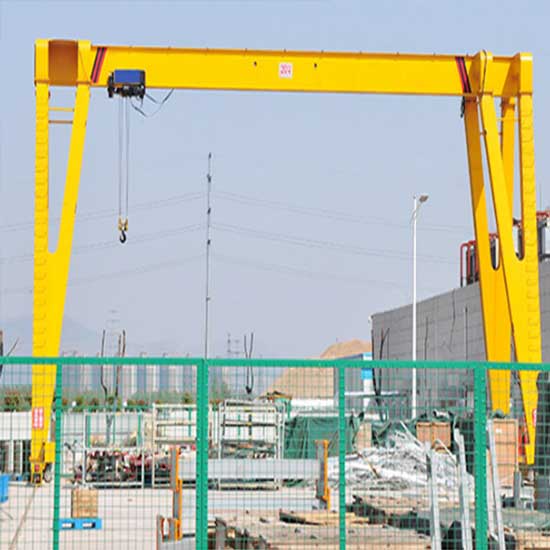
Single girder hoist gantry cranes, FEM,DIN & ISO standards: Single beam gantry cranes, European style box girder, FEM hoists for 3 ton, 5 ton, 10 ton, & 16 ton load handling.
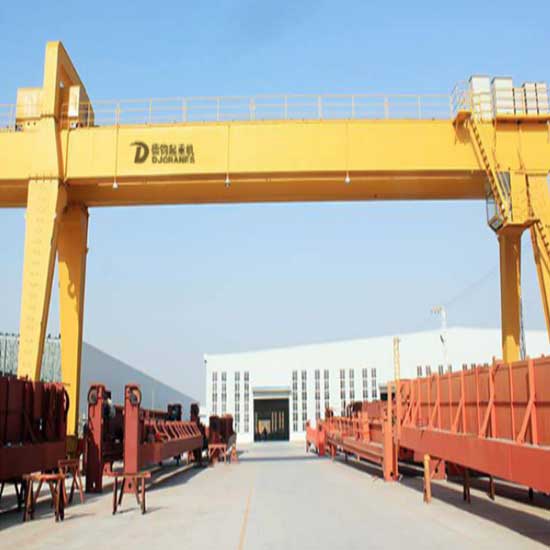
European style double girder hoist trolley gantry cranes: European type double girder gantry cranes with FEM standard wire rope hoists trolley with capacity of 5 ton up to 75 ton for sale.
3.Maintain your eequipment
You've followed the first two instructions and have all of the necessary tools in their own designated area, which is fantastic!Now it's up to you to keep those tools in good working order.Not only is a dull saw blade inefficient, but it's also dangerous.Poorly maintained equipment will result in a reduction in output at best, and will result in someone being gravely wounded or killed at worst.The good news is that if you maintain your equipment properly, it will last longer and be a larger benefit to your company.
If your company owns a few work vans or vehicles, selling them will be considerably easier if they have a long service history and are in good condition.When it comes time to upgrade, this means less money will be taken out of the firm.Most devices and equipment that may need to be upgraded in the future are in the same boat.
4.Streamline the process
If there is any waste in the process, it will show up in your company's financial statements.The firm intended to replicate Toyota's production line process, which they had perfected.The factory saw significant benefits after implementing some of the optimized processes.You will see a significant boost in your business if you concentrate more on your procedure.
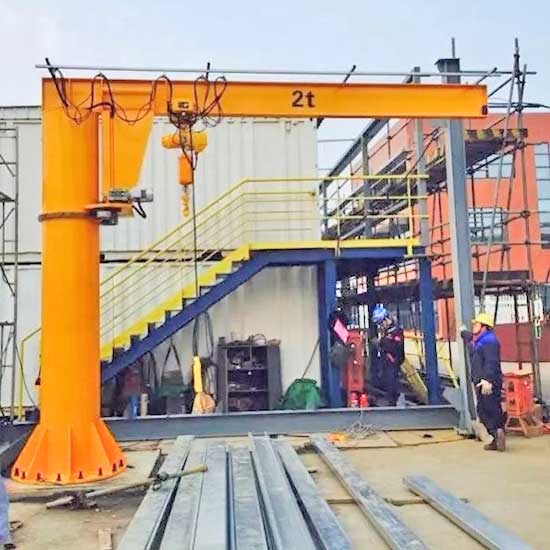
Free standing jib crane-Pillar mounted jib crane is a free standing jib crane with pillar jib mounted on floor, for short & crowded lifting, capacity up to 16 ton.
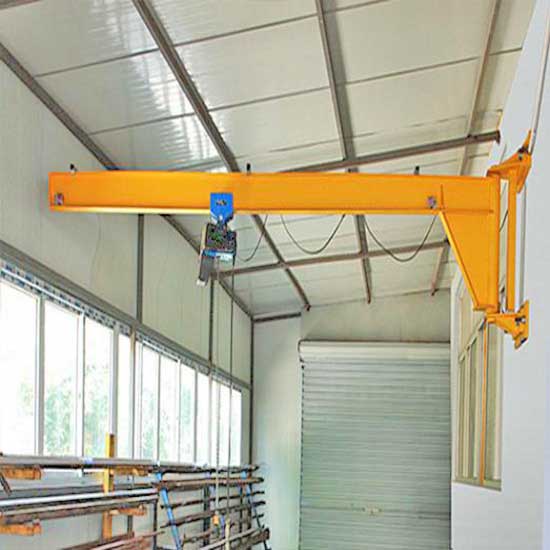
Wall mounted jib crane & wall bracket jib crane with I beam & tie rod design for light duty handling with capacity up 2 ton. or less building structure changes.
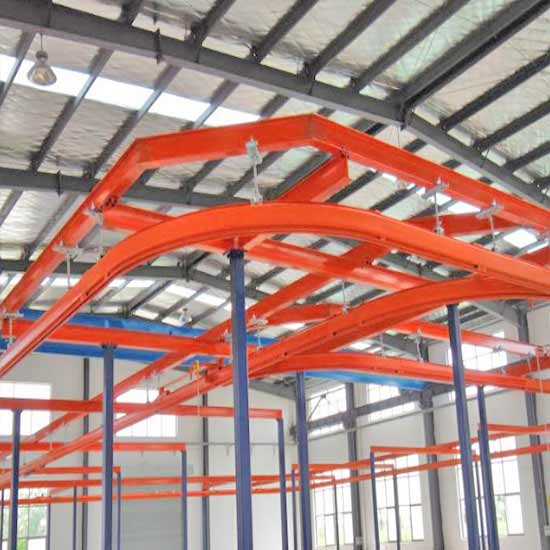
Light crane kbk system-kbk light crane systems, flexible kbk crane & rigid kbk crane, modular crane design, cost-effective workstation crane solution, tailored light duty bridge crane.
5.Get employee input
As a manager or factory owner, you may have a decent understanding of the production line process, but odds are you don't spend forty hours a week on it.
So why would you think you know more about simplifying manufacturing than someone who works with the process forty hours a week?Because we have the power to hire and fire our colleagues, we sometimes believe we know more than they do. This assumption is frequently incorrect.
It doesn't hurt to ask your employees, even if you're an expert on your manufacturing line and know how to make the process run more smoothly.Asking your employees, "How can I make your work faster/more efficient/easier?" is a great way to start. You'll show that you value their opinions and don't want to squander their time by forcing them to work inefficiently.As a result, you'll get more respect as a leader and your staff will feel more valued, which will benefit your organization in two ways.When you do seek for advice from your staff, make a list of their proposals and strive to put the most practical ones into action.
6.Focus on employee training
I'm not talking about the kind of training that teaches you what to do in the event of a disaster.Rather, it's the kind of training that asks, "How can I get a lot better at my job?"You're providing a lot of value to your employees by focusing on helping them improve their on-the-job abilities. A master welder can command significantly higher wages than an entry-level welder.But the best part is that the quality of their work will improve as their talents develop.As a result, your factory's products will be of superior quality.
Another way to look at it is as follows.If you provide opportunities for your employees to enhance their abilities, you may find that some of them become more enthusiastic about their work.Instead of perceiving certain things as a chore, they may learn to perceive them as a challenge that must be met straight on.It makes no difference what task you're working on.If your person does an excellent job, they may feel pleased of themselves for doing so.This is a huge win-win situation for both your company and your staff.You will also be fostering their enthusiasm by getting them to be talented enough at their job to do consistently exceptional work.All you have to do now is focus on getting them the proper training.
7.Encourage (or even mandate) greater communication
- Limiting the number of setbacks or workplace mishaps that may occur is one approach to ensure we stay ahead of the competition.
- Usually, these mishaps can be avoided by not putting all of the burden for the task at hand on one individual.
- Checklists read aloud from one person to the next are an excellent technique to increase communication.
- Making this a part of the manufacturing process is an often-overlooked opportunity to boost efficiency and safety.
- Employees gain the benefit of an extra set of eyes to ensure they aren't forgetting anything crucial or about to do something risky by communicating throughout some of the more dangerous portions of the production process.
- This is beneficial to new employees because it prevents them from making mistakes that a more experienced employee would notice.
- It's also beneficial to experienced personnel who may believe that because of their experience, they can operate on autopilot during critical stages of the manufacturing process.
- I know several seasoned woodworkers who would have kept more of their fingers if they had adhered to certain safety precautions.
- Injuries can result in time off or, in the worst-case scenario, complete loss of function. You don't want to lose your most senior personnel to something that could have been avoided.
It will also force you to streamline your approach.
Conclusion
Start gently if you want to make the most of these adjustments.If you start making drastic changes to everything, you'll likely face a lot of pushback from your employees.
We may examine your factory's problem areas and begin with the solution that best addresses the most serious issue.We have over 34 years of experience working with manufacturing plants and are experts in manufacturing workflows. For your location, we may design a personalized work area and floor layout.Your workspace will be drastically changed after working with We. There will be less downtime in your factory, and it will be more efficient and lucrative. If you have any problem on material handling crane and hoist or on improve your material handling efficiency in your assembly line, please feel free to contact us by Whatsapp/ Wechat: + 86 151 3871 1597.